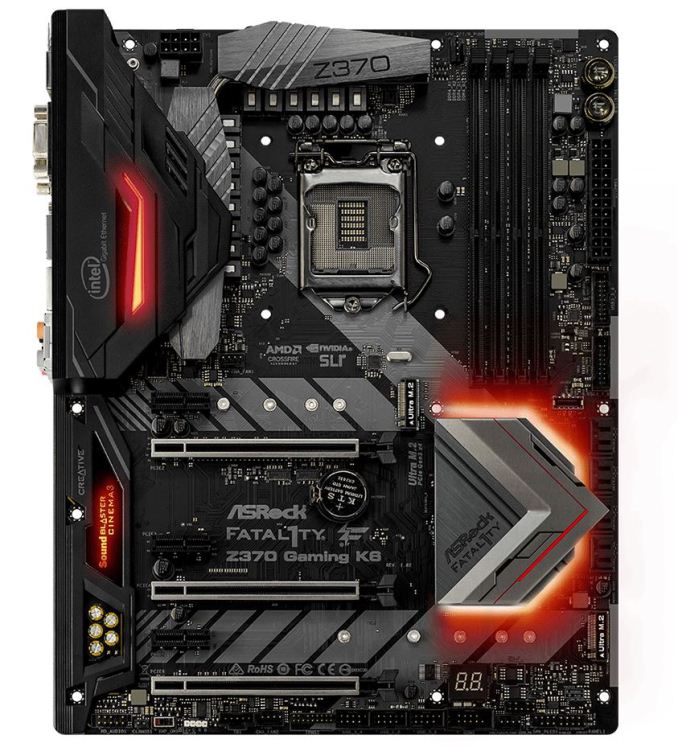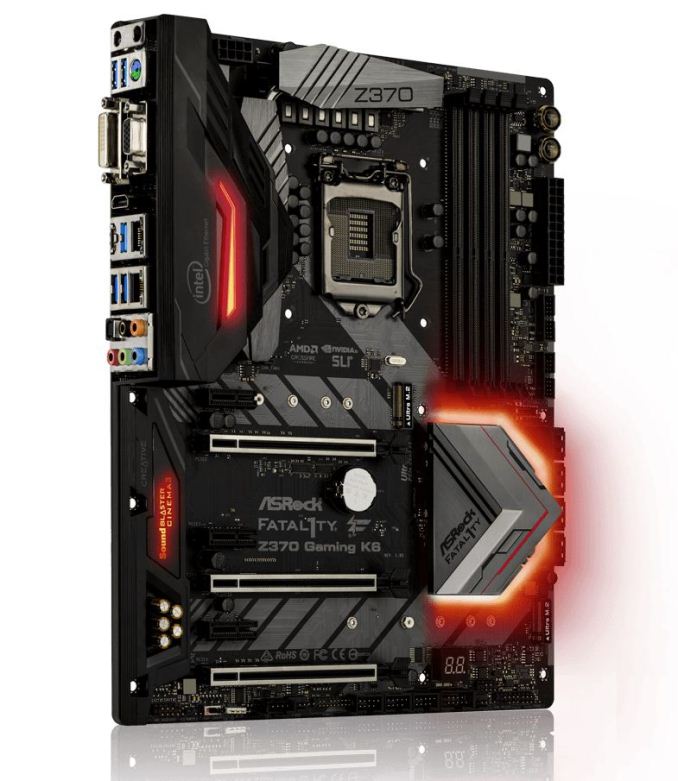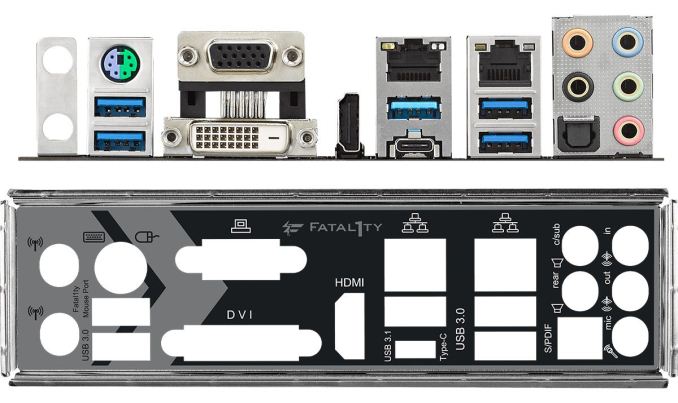Analyzing Z370 for Intel's 8th Generation Coffee Lake: A Quick Look at 50+ Motherboards
by Ian Cutress, Anton Shilov, Joe Shields & Gavin Bonshor on October 20, 2017 2:00 PM ESTASRock Z370 Gaming K6
The Gaming K6 is the second board in the Gaming lineup. The board is styled similarly but has fewer features when comparing it to the flagship, such as removing some of the premium features like 10-gigabit Ethernet.
The overall appearance of the board is nearly the same as its big brother. The differences worth mentioning is the power and reset buttons have moved from next to the debug LED at the bottom right to the top right-hand corner. The debug LED remains in the same location as well as the other RGB LEDs in the shrouds and chipset heatsink. Additional strips can be added using the RGB header located on the bottom of the board.
Memory capacity and supported speeds are the same as the high-end model, at 64GB and DDR4-4333 respectively. There are three reinforced full-length PCIe slots, capable of running at x16 single, x8/x8 dual, and x8/x4/x4 when all are populated. To accompany this are three open-ended PCIe x1 slots, supporting larger cards but only at x1 bandwidth. This lane configuration allows support for 2-way SLI and 3-Way Crossfire.
The Gaming K6 breaks the regular Z370 mold and gives users eight SATA ports, six from the chipset and two additional ports from an ASM1061 controller. Two M.2 slots are on the K6 with the top one supporting 80mm drives and the other one nearer the chipset supporting up to 110mm. The first M.2 slot shares lanes with SATA 0/1 ports while the second shared with SATA 4/5 ports when SATA drives are connected.
Audio is handled by the Realtek ALC1220 codec and offers the same features as the flagship Pro Gaming i7 using Nichicon Gold series audio caps and the same NE5532 headset amplifier. Sound shaping is handled by the Creative Sound Blaster Cinema 3 software. Networking responsibilities are handed off to two Intel NICs, an I219-V and I211-AT. Though wireless networking isn’t included, there is an M.2 E-Key slot in the back panel if needed.
USB connectivity is similar with the K6 offering a front panel USB 3.1 (10 Gbps) Type-C port as well as Type-C and Type-A ports on the back panel using an ASMedia chipset. Four USB 3.1 (5 Gbps) ports are on the rear panel, with two additional headers on board. Six USB 2.0 ports via three headers are also supported. The rear panel IO also has a combination PS/2 port, and uses D-Sub, DVI-D and HDMI video outputs.













83 Comments
View All Comments
sor - Friday, October 20, 2017 - link
Damn. At least key it differently and call it LGA1151v2 or something.The changes are so minimal it really does seem like planned obsolescence. Does it really need more power pins to support new chips with the same power envelopes? Really? They couldn’t handle that on the CPU PCB?
KaarlisK - Saturday, October 21, 2017 - link
Actually it is ~1.5 times peak current with the same average power envelope, so yes, they need the change.If they had not brought the launch forward and just launched together with the cheap chipsets, there would be far less complaints.
sor - Saturday, October 21, 2017 - link
Where did you find information indicating current has increased 50%? I just spent about ten minutes trying to find a reference backing that up, perhaps something indicating the 8 series operates at a much lower voltage within same TDP, which would translate to higher current but they seem to operate in the same 1.2-1.3v range.You’re not just assuming they draw more current because they have two more cores, are you?
KaarlisK - Sunday, October 22, 2017 - link
Notice the difference between average and peak.And the information is in publicly available documents. I did not bother to look it up, but others have, for example: https://forum.beyond3d.com/threads/intel-coffee-la...
Crono - Saturday, October 21, 2017 - link
Nice roundup. That's a lot of motherboards to spec and summarize. I especially appreciate the handy chart at the end, it's a good, quick-and-dirty comparison tool.Landcross - Saturday, October 21, 2017 - link
You guys forgot 2 new Z370 boards from Supermicro :)https://motherboarddb.com/motherboards/?chipset=19...
Xpl1c1t - Sunday, October 22, 2017 - link
The mITX board looks incredible.+ Low ESR Tantalum capacitors! (first time seeing them on VRM duty on a mainboard)
+ HDMI 2.0
+ 2x M.2 Slots
+ USB 3.1 Type C
+ Optical SPDIF
- RGB.......
MadAd - Saturday, October 21, 2017 - link
Great write up but for me its just another depressing generation of oversized, overpriced ATX form factor offerings on which the vast majority of users wont even plug a second gpu into, with the smaller and more size appropriate FF represented as a minority afterthought.With all the progress of PCs since the 90s whod have thought that I could still use the same ATX case today while every single other component (from floppy drives to 2d Mattrox cards) have long gone to the recyclers. I find it so annoying how manufacturers have stuck on this prehistoric gargantuan case size with the other sizes being an afterthought. It feels like like stifled innovation while everything else is moving on.
rocky12345 - Saturday, October 21, 2017 - link
Great article and a lot of work put in to get it out for us to read thank you.My only issue is and it is nit your fault is why these companies feel the need to totally blanket the market with basically the same boards just a different model number and basically a few tiny changes and spray paint it a different color and use the word gaming and put something x or x1 or k,k3 etc etc. For crap sakes just release three models not 7-10 models of the same crap it is pretty much just greed I guess.
The whole market is like this now with anything computer related of and if it has the words GAMING or RGB in it's got to be good for sure. My fav is that gaming mouse pad next it will have RGB lighting in it...lol
CitizenZer0 - Wednesday, October 25, 2017 - link
Agreed